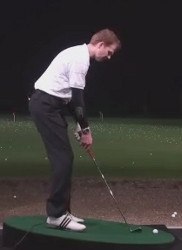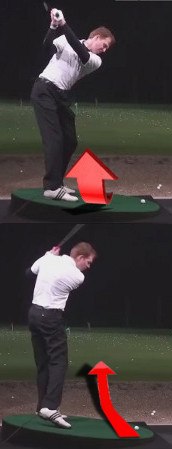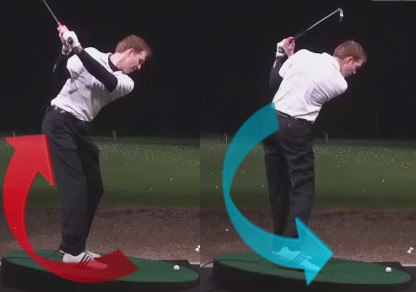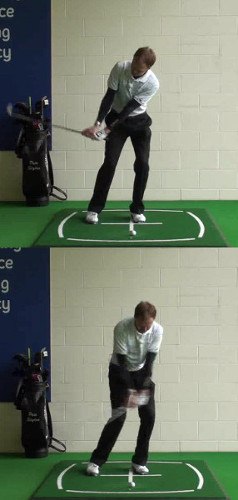
The average golfer has enough trouble avoiding a slice from a perfectly flat lie. It becomes doubly difficult when the ball lies below the feet.
When you're perched above the level of the ball on a side slope, you naturally stand closer to the ball. The swing becomes more upright or vertical, which can cause (or exacerbate) an over-the-top clubhead path.
Take these steps to master the ball-below-your-feet stance:
- Take one more club: To reach a ball below your feet, you'll have to grip the club near the butt end, costing you control. Instead, play one more club (a 6-iron instead of a 7, for instance), use your normal grip, and make an easy swing.
- Bend from the knees: To reach the ball, many golfers bend over from the waist, pushing their weight too far onto the toes. Flex your knees a little extra and maintain balance in the middle of the feet.
- Aim left: The bigger the slope, the harder it is to avoid hitting the ball to the right. Rather than fight it, simply aim left of target and play for a push-fade.
- Keep your shoulders level throughout the swing: It's common to rise up and off the ball on the backswing and follow-through. Focus on swinging with the shoulders parallel to the ground from start to finish for solid contact.
Golf Ball Videos:
- Compression Video
- Spin Video
- Dimples Video
- Golf Ball Brands Video
- Titleist Video
- Understanding Spin Video

How to Hit a Golf Ball That's Below Your Feet
Golf would be a pretty simple game if it were always played on flat courses. Without uneven lies to deal with, or elevation change to calculate, you would almost certainly shoot lower scores. Of course, the game would also be rather boring. The terrain of each individual course is part of what makes this game interesting as the years go by. Where most sports have the same playing field no matter where you are, each individual golf course is unique. People keep coming back to this game time and time again in large part due to the diversity among courses.
One of the challenging shots you will face as a result of playing on uneven ground is hitting a ball which is resting below the level of your feet. It is hard to hit a solid shot from this situation, especially if you are trying to hit a long club. It is possible to play a good shot while the ball is below your feet, but doing so is going to require a combination of solid technique and plenty of practice. Typically, only experienced and well-prepared golfers will be able to succeed under these conditions.
In this article, we are going to provide some ideas for how you can deal with this tricky shot. While you might not ever be as comfortable with the ball below your feet as you would be on a level lie, the advice we will offer below should at least help to improve your results. One of the best ways to improve your golf game as a whole is to reduce the number of different shots that give you trouble. In other words, you should be trying to eliminate your weaknesses, one at a time. Once you learn how to play shots with the ball below your feet, you will be able to check that box and move on to another. Repeat this process over time and you will soon become a well-rounded, consistent player.
Before we get too far into this article, it should be said that the best course of action is always going to be positioning your ball on a relatively flat part of the course. When possible, aim tee shots for flat sections of fairway so you can hit your next shot from the best possible lie. This strategy won't always be available, of course, but you should put it to use when it is a realistic option. Course management and strategy are a big part of success on the links, so never hit a shot without first thinking about what it is going to mean for your next shot. Put the ball in smart positions and the game will suddenly seem a lot easier.
All of the content below is based on a right-handed golfer. If you happen to play left-handed, please take a moment to reverse the directions as necessary.
Golf Ball Videos:
- Compression Video
- Spin Video
- Dimples Video
- Golf Ball Brands Video
- Titleist Video
- Understanding Spin Video

The Main Challenge
There is one specific challenge that you are going to have to overcome if you are going to play good shots when the ball is below your feet – reaching the ball at impact. You can't make your golf clubs any longer for this kind of shot, and your arms aren't going to get longer, either. Your set of clubs is designed to make it easy for you to hit the ball from a level lie, meaning you will have trouble reaching the ball when it is sitting down below you. Everything you do when preparing to hit this shot should be based around the goal of overcoming this challenge.
So how can you manage to reach the ball when there is nothing you can do to extend your arms or the length of the club? To overcome this problem, you will need to get lower to the ground. At address, you are going to bend your knees more for this shot than you would for a similar shot played from flat ground. Adding flex to your knees is going to bring you down closer to the level of the ball, and you should have a much easier time achieving a clean strike as a result. The severity of the slope is going to determine how much you need to bend – add a lot of flex for a steep hill, or just a little flex for a minor grade.
By using knee flex to counteract the effect of the hill, you will have taken a big part of the challenge of this shot away. Also, you will have avoided making a classic mistake when playing this shot – bending too much at the waist. Many amateur golfers simply bend more from the waist when trying to reach the ball in this situation, but that is a bad idea. Adjusting your upper body posture is going to affect your swing plane, and you will struggle to make solid contact. You will also have trouble making a full turn, meaning you are going to lose a significant amount of distance. Do your best in this situation to keep your upper body in its usual position while your lower body does the work of adjusting to the lie.
At this point, you might be thinking this all sounds pretty easy – just bend your knees more and swing away, right? Well, not so fast. Just like anything else in golf, you are going to have to practice this technique if you are going to be successful. Of course, nearly every driving range in the world is flat, making it difficult to practice shots where the ball is resting below your feet. To get around this problem, follow the steps below.
- Head out to the driving range with a bucket of golf balls to hit and at least a few clubs. You are going to start this drill with your seven iron, but you can move on to use other clubs as well. However, there is no real point in using your driver on this drill, as you shouldn't ever need to hit it from an uneven lie.
- With your seven iron in hand, place a ball down in front of you and get ready to hit your first shot. Before making a swing, be sure to pick a target. No matter what kind of shot you are practicing on the range, you always want to have a target in mind. Golf is a target-based game, after all.
- To imitate the kind of swing you will make when the ball is below your feet, you are going to put extra flex in your knees before hitting these shots. To make up for the fact that the ball is not actually below your feet while on the range, you are going to choke down on the grip of the club. This will prevent the club from being too long for the shot, and you should be able to get a feel for making a swing while your knees have extra flex. This is not a perfect solution, but it is a good alternative when you can't actually practice on a slope.
- Hit a handful of balls this way before switching clubs and continuing on. You obviously don't need to practice like this all the time, but even hitting just a few shots this way during each practice session will go a long way.
You should always do your best to practice things on the range that you are going to use on the course. In fact, it is a good rule of thumb to avoid hitting any shots on the course that you have not first practiced on the range. By working on this simple drill during a typical range session, you will be better prepared to deal with situations where the ball is resting below your feet.
Golf Ball Videos:
- Compression Video
- Spin Video
- Dimples Video
- Golf Ball Brands Video
- Titleist Video
- Understanding Spin Video

Other Challenges
The biggest issue you face on this shot is managing to make solid contact despite the ball being significantly lower than it is on other shots. As we covered above, the best way to get over that issue is to add flex to your knees. Unfortunately, even after you make that adjustment, you are still going to run into some other issues with regard to this challenging situation. Those issues are listed below.
- Difficulty getting the ball on line. It is always difficult to hit your intended target line when you are playing with the ball well below your feet. Most often, you will hit the ball in the direction of the slope – meaning a right-handed golfer will usually push the ball to the right in this circumstance. However, that is not a hard and fast rule, as it is also possible to pull the ball if you let the heel of the club get stuck in the turf. The best way to learn how your ball flight is going to react to the slope is simply to gain experience. As you hit more and more shots from these kinds of lies, you will get better at predicting where the ball is going to go. You should never make the mistake of assuming that the ball is going to take the same flight that it takes from flat ground – that is rarely going to be true.
- Covering the full distance to your target. Even if you do everything right, you are still likely to hit the ball shorter from this kind of lie than you would from a flat lie. To make sure you can cover the full number to the target, use one more club than you would use otherwise for that distance. You don't want to be swinging a full effort in this situation, since swinging hard is going to cause you to fall off balance. Swing easy, use plenty of club for the shot, and focus first and foremost on solid contact.
- Additional slopes. It isn't always going to be the case that the ball will simply be below your feet – in many cases, it will also be sitting on an upslope or downswing. When that happens, you need to think about every dimension of the lie prior to hitting your shot. On an upslope, the ball is going to fly higher in the air, and a shorter overall distance, so you must pick your club accordingly. On a downslope, the opposite will be true. The ball will fly lower to the ground, and usually go farther as well. Shots played from two slopes at the same time are difficult to say the least, but you can conquer them if you think through your planning carefully.
- A poor lie. The lie of your golf ball not only refers to the slope of the area around the ball, but also to the grass itself. If your golf ball is sitting down in some long grass, or if it is sitting on a bare patch with no grass at all, you will need to respond appropriately. Generally speaking, you should be trying to play the easiest shot possible when you have a bad lie. Aim for the middle of the green, make a controlled swing, and don't try to do too much with the ball. The main objective when you have a bad lie is to move on to the next shot as safely as you can. Don't let this bad lie do any more damage to your scorecard than it has to – be smart and move on with your round.
It is tricky to play a shot where the ball is sitting well below the level of your feet. In addition to needing to adjust your stance, you need to pay attention to the points listed above as well. This is one of the toughest situations you will find on the course, and it is only going to be conquered through practice and attention to detail.
Golf Ball Videos:
- Compression Video
- Spin Video
- Dimples Video
- Golf Ball Brands Video
- Titleist Video
- Understanding Spin Video

Staying Away
As was briefly mentioned earlier, one of the keys to these shots is simply avoiding them in the first place. Unless the entire fairway is tilted from one side to the other – which you will find from time to time – the best thing you can do is hit an accurate tee shot which keeps you away from a sloped lie. The list below includes some game planning tips which may be able to help you stay off of the slanted pieces of the fairway.
- Use less club. You don't have to hit your driver off the tee on every par four and par five. We know that is radical thinking for the average golfer, but it really is important to open your mind to other options. If the fairway is rather sloped at the distance you expect to achieve with your driver, put down the big stick and play the shot with a three wood or hybrid instead. You will be able to stay short of the sloped turf this way, and you will also increase your chances of hitting the fairway. This is not only a good strategy to use on holes with steep fairways – it is a good way to think in general as you try to get your ball around the golf course.
- Use the appropriate curve. If you have the ability to curve your ball in both directions, pick your trajectory based on the slopes you see in the fairway. When the right side of the fairway is sloped, for instance, play a draw to turn your tee shot away from that side. This method isn't always going to be successful, but it will help you avoid putting your ball in a tough place too frequently. Of course, curving the ball on demand is an advanced skill in this game, so don't try this on the course until you have practiced it on the range.
- Consider the rough. This might seem a little crazy at first, but it is actually the best choice in some cases. When playing a course which features very little rough – as is the case with most modern golf courses – you may be better off playing the ball into the rough intentionally rather than finding a sloped fairway. If you see that a section of the rough is relatively flat and will give you good angle at the target, think about aiming your shot in that direction even though that means missing the short grass. You will still want to aim for the fairway most of the time, of course, but planning on finding the rough does work when the fairway isn't an attractive choice.
One of the keys to being a good golfer is managing your way around the course in a logical manner. You don't want to put the ball anywhere which is going to leave you with a difficult shot – so avoid that outcome whenever possible. Think through all of your options before each tee shot and look for any way you can find to steer clear of sloped ground.
Golf Ball Videos:
- Compression Video
- Spin Video
- Dimples Video
- Golf Ball Brands Video
- Titleist Video
- Understanding Spin Video

Chipping with the Ball Below Your Feet
Obviously, you will encounter uneven lies all over the golf course, not just when the ball is in the fairway for an approach shot. In fact, it is even more common to find the ball sitting below your feet when chipping, as the ground around the green is usually sloped in one direction or another. If you are going to get up and down at a high rate, you need to know how to chip and pitch the ball successfully even when you don't have a flat lie.
The first thing to do when chipping in this situation is the same thing you would do for a full shot – add flex to your knees. This is going to take you down closer to the level of the ball, just as it does for your full swing. Also, you need to widen your stance, which will give you more stability as the swing unfolds. It is hard to hold your balance in this situation, but playing from a wide stance will help you remain steady. With a wide stance and plenty of flex in your knees, you should now feel like you are in a good position to hit the chip shot solidly.
When chipping on a slope, your ball is likely going to be sitting in the rough. If that is the case, try swinging slightly from outside to inside by using an open stance. Using this path is going to help you make solid contact is a good choice as the steeper angle of attack will mean the club can avoid the grass behind the ball. Also, swinging across the ball from the outside will add loft to the shot, which is usually helpful in this kind of spot.
Fortunately, it is easier to prepare for this kind of shot than it is for the full swing shot with the ball below your feet. Why? Simple – most courses have practice chipping areas that feature uneven ground. Head to the chipping green at your local course and find a lie where the ball is below your feet. Hit several shots from this kind of lie, then switch and hit several more with the ball above your feet. Chipping over and over again from a perfect lie doesn't really prepare you for the challenges you are going to face on the course. Do your best to find difficult lies and learn how to deal with them appropriately.
Everyone would love to find their ball on a flat lie at all times, although that would make the game somewhat boring in the long run. As a game which is played outdoors on big pieces of property, there are always going to be interesting lies to deal with during a round of golf. Don't expect things to be perfect when you play – it is part of the game to have to deal with tough spots. Prepare yourself for these situations through detailed practice and head out onto the course with confidence that you can rise to any challenge your lie may present. Good luck!
Golf Ball Videos:
- Compression Video
- Spin Video
- Dimples Video
- Golf Ball Brands Video
- Titleist Video
- Understanding Spin Video






